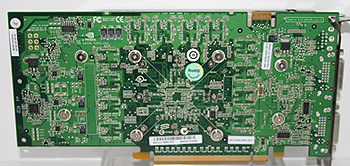Zotac have two versions of the GeForce 8800 GTS 320MiB, one overclocked from the factory and one at the stock clocks shown on the left. ZT-88SE320-FPP is the overclocked version, running at 570/1200/900 (base/shader/memory), up from 500/1200/800 of the reference design, and is the version we're reviewing here. Note that shader clock frequency doesn't increase, with only the base chip clock and memory clock seeing a boost.
Zotac didn't do anything to change the physical properties of the board, ZT-88SE320-FPP following the NVIDIA reference PCB and cooler specification to the letter. The dual-slot cooler exhausts generated heat from the GPU and DRAM devices out via the rear of the chassis via a slotted backplane.
As you can see, bar the sticker on the cooler assembly, the graphics board itself is unchanged from the reference design. PC Partner mention that the board production for this particular SKU is done in-house as part of the production run they're doing for other vendors, backing that up. The rotary blower-style fan the cooler utilises is a very quiet one until around 75% of maximum speed, which is the point where it starts to become heard over other noise our test system makes. More on that later.
Taking the cooler off of our sample shows the same HY5RS573225A devices used on the reference hardware, and on the sample they're the 1.1ns devices you'd expect for a 900MHz memory clock. Being a 320MiB board, using 32MiB DRAMs with 12 spots to put them in, two placements are unused. That gives rise to the 8800 GTS SKUs having a 320-bit memory bus (two 32-bit DRAM channels unused) with five quad ROPs enabled (compared to the 6 on an 8800 GTX).
Zotac simply change the board BIOS to create their overclocked SKU. We note that there doesn't appear to be any support for a '2D' clock domain, where voltage and operating frequencies for the chip and DRAMs are reduced to save power and reduce operating temperatures. Rather, the board runs at full speed and voltage all of the time. In practice, that doesn't equate to static power consumption regardless of what the board is being asked to draw, but there is opportunity for power and heat to be reduced with the use of a different performance profile in the board's BIOS with a G80 board, we think.
So with the physicals and spec defined, how are Zotac going about marketing via the presentation and what comes in the box? Let's find out.


